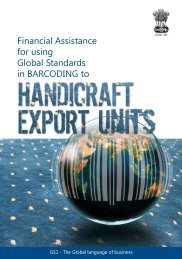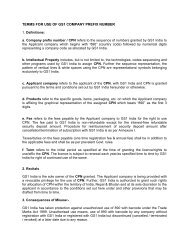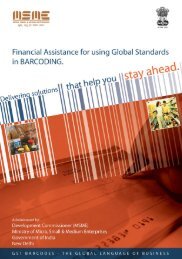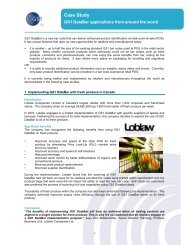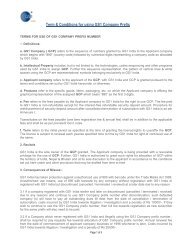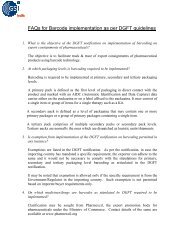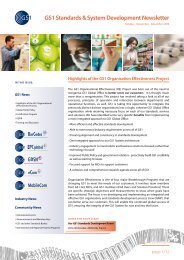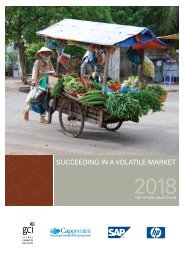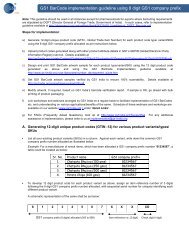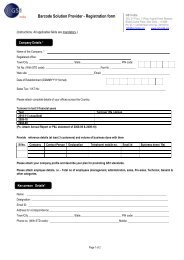GS1 Standards- connecting brands with consumers - GS1 India
GS1 Standards- connecting brands with consumers - GS1 India
GS1 Standards- connecting brands with consumers - GS1 India
You also want an ePaper? Increase the reach of your titles
YUMPU automatically turns print PDFs into web optimized ePapers that Google loves.
<strong>GS1</strong> <strong>Standards</strong>- <strong>connecting</strong> <strong>brands</strong> <strong>with</strong> <strong>consumers</strong><br />
Coupons, promotional packs and loyalty cards coding<br />
Brand owners/retailers take constant<br />
measures to boost sales of their products by<br />
introducing promotional packs, coupons and<br />
loyalty card programs.<br />
Brand owners today have many more options<br />
to connect <strong>with</strong> their <strong>consumers</strong> than by<br />
publishing advertisements which are<br />
expensive and hence can be undertaken only<br />
infrequently. They can use coupons or<br />
vouchers for allowing a financial discount;<br />
loyalty based programs to increase consumer<br />
adherence or simply introduce a promotional<br />
pack as a means of delivering samples to the<br />
<strong>consumers</strong> to boost a product launch. Welldesigned<br />
voucher programs can add as much<br />
as a full percentage point to market share on<br />
a product launch, or can add a month’s worth<br />
of days-on-purchasing (a measure of<br />
consumer adherence).<br />
A. Issuing coupons – capturing price conscious <strong>consumers</strong><br />
Coupons often provide <strong>consumers</strong> <strong>with</strong> an additional<br />
incentive to make a purchase over and above what they<br />
initially intended. Since only price conscious <strong>consumers</strong><br />
are likely to spend the time to claim the savings, coupons<br />
function as a form of price discrimination, enabling<br />
retailers to offer a lower price only to those <strong>consumers</strong><br />
who would otherwise go elsewhere. In addition, coupons<br />
can also be targeted selectively to regional markets in<br />
which price competition is high.<br />
Need for barcoding coupons using barcodes<br />
Due to high usage of coupons, it is imperative to facilitate automated data capture of coupon information<br />
through barcodes for their unique and universal identification and capture of related attribute information<br />
using <strong>GS1</strong> global standards. This would enable several applications/benefits as enumerated below:<br />
• Automate and speed up coupon handling procedures at the Point-of-Sale.<br />
• Enable coupon issuers (brand owners/manufacturers/retailers) to reduce the costs involved in coupon<br />
sorting, administering manufacturers’ payments, and producing reports on redemption.<br />
• Capture coupon value options in any amount up to 999.99.<br />
• More complex coupon offers <strong>with</strong> better validation methods and enhanced couponing capacities<br />
• Enable automatic expiration date checking by retailers.<br />
• Enable coupon fraud reduction<br />
Detailed <strong>GS1</strong> implementation guideline for barcoding using <strong>GS1</strong> standards for coupons is available at<br />
www.gs1us.org/databar
B. Servicing loyal customers through loyalty cards<br />
Loyalty programs are structured marketing efforts that reward, and therefore encourage, loyal buying<br />
behaviour. Loyalty cards helps to identify the card holder as a recipient of services under a loyalty program.<br />
It is important to use an identification key on the loyalty card to identify the customer and update purchase<br />
history. The Global Service Relation Number (GSRN) is the <strong>GS1</strong> identification key used to identify the<br />
relationship between a service provider and service recipient under a loyalty programme.<br />
The GSRN identifies each service relationship individually thus ensuring that it is always identified correctly<br />
anywhere <strong>with</strong>in a business or the world. An individual may have many GSRN’s from different service<br />
providers. As it is the service provider that allocates the GSRN there is no danger of the individual’s other<br />
service relationships being linked.<br />
Benefits of using GSRN<br />
Already an established standard for identifying service relationships<br />
Identifies the business relationship <strong>with</strong> the customer for the life of the service<br />
Is simple coding system to facilitate service relationships <strong>with</strong> almost limitless capacity<br />
Utilises <strong>GS1</strong> standards as used in many other business applications<br />
Enables companies to scan an individual’s membership card to identify the service efficiently<br />
Guards against mis-identification and fraud<br />
Facilitates development of customer loyalty<br />
GSRN is an 18 digit numerical number. It is represented schematically as below:<br />
( 8018) 890900100000000012<br />
890900100 00000001 2<br />
<strong>GS1</strong> company prefix Number allocated to identify the card holder check digit<br />
Detailed <strong>GS1</strong> implementation guideline for generation of GSRN and its use in loyalty cards is available at<br />
http://www.gs1.org/barcodes/technical/idkeys/gsrn<br />
C. Coding of promotional packs<br />
Making a sale often depends on more than simple brand loyalty. Marketers need to encourage more, offer<br />
more, and incentivise more by offering promotional packs. Just like general consumer items, promotional<br />
packs also need to be marked uniquely and universally using GTIN (Global trade identification number) for<br />
accurate scanning and compatible identification.<br />
<strong>GS1</strong>, in collaboration <strong>with</strong> retailers and brand owners, has developed detailed guidelines for coding of<br />
promotional packs. Some details of the same for ready guidance are reproduced as below:<br />
Applications/benefits of using GTIN’s for promotional packs coding<br />
Allows companies to trade promotional packs knowing that the identification will be compatible<br />
Uniquely identifies each level of packaging<br />
Facilitates accurate scanning at checkout, warehouse<br />
Essential for accurate stock control and order replenishment<br />
Drives electronic communications systems like EDI, across trading partners<br />
Identifies trade items for data exchange between trading partners as a required component of a GDSN<br />
(Global Data Synchronisation Network)<br />
Ability to add additional information such as date codes, weight, batch numbers etc<br />
Provide accuracy, speed and efficiency for your business<br />
Page 2 of 3
GTIN allocation rules for promotional packs<br />
Promotional Type Description <strong>GS1</strong> specification<br />
Sample or test pack A free pack of the trade item GTIN to be used for<br />
identification of the sample<br />
Bonus pack<br />
An item <strong>with</strong> increased quantity, i.e. net weight or count<br />
or volume but sold at the same price as the regular item.<br />
New GTIN<br />
Gift pack: type-I<br />
Gift pack: type-II<br />
Gift pack: type - III<br />
Two retail consumer trade items, not attached or banded<br />
together where one item, which cannot be purchased, is<br />
free when the other is purchased (e.g. gift-<strong>with</strong>-purchase<br />
or purchase-<strong>with</strong> purchase items<br />
Two or more retail consumer trade items bound<br />
together, i.e. designed to promote the trial of the<br />
attachment (One-Order Trial Packs) where the geometry<br />
of the base package and the item net weight, count or<br />
volume is not impacted and the item is not intended to<br />
be reordered because the promotion period is limited.)<br />
A free item packed inside the primary retail consumer<br />
trade item package <strong>with</strong> no change in quantity of trade<br />
item and the promotion package is sold at the same<br />
price as the regular package<br />
No need to change the<br />
existing GTIN<br />
No need to change the<br />
existing GTIN<br />
No need to change the<br />
existing GTIN<br />
Gift pack: type-IV<br />
Merchandise sold<br />
<strong>with</strong> allowance<br />
Reconfiguration of<br />
consumer pack<br />
Two or more retail consumer trade items near each<br />
other (not attached or banded together) both of which<br />
can be purchased separately. For example a gift-<strong>with</strong>purchase<br />
or buy-two-get-one- free offers - these items<br />
are offered at no additional cost when the primary<br />
(regular) retail consumer trade item is purchased. The<br />
promotion is sold at the same price<br />
When items are purchased by the retailer at the regular<br />
price and additional items are furnished free of charge.<br />
A consumer package reconfigured for promotional<br />
purposes which contains the same quantity of trade item<br />
as the regular package and is sold at the same price.<br />
No need to change the<br />
existing GTIN<br />
If the quantity of regular<br />
cases is increased there is<br />
no need to change the<br />
standard existing GTIN<br />
Same GTIN<br />
Combination pack<br />
Combination packs are composed of two or more retail<br />
trade items normally sold separately, that are bound<br />
together.<br />
New GTIN - The original<br />
GTIN barcodes of the<br />
retail items should not be<br />
visible.<br />
Detailed <strong>GS1</strong> implementation guideline for coding of promotional packs is available at<br />
http://www.gs1.org/1/gtinrules/index.php/nid=96.<br />
For any further help or assistance, write to us at info@gs1india.org<br />
<strong>GS1</strong>- the global language of business<br />
Page 3 of 3




